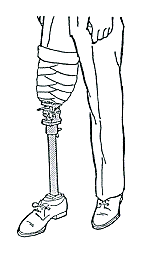 Fitting a prosthesis as soon alter surgery as possible helps to combat edema. A preparatory prosthesis is frequently used for several weeks or months until the stump has stabilized before the "permanent" or definitive prosthesis is provided.
Fitting a prosthesis as soon alter surgery as possible helps to combat edema. A preparatory prosthesis is frequently used for several weeks or months until the stump has stabilized before the "permanent" or definitive prosthesis is provided.
The socket of the preparatory prosthesis may be made of either plaster-of-Paris or a plastic material, and is attached to an artificial foot by a lightweight tube or strut, often called a "pylon." When indicated, a suction socket is used. Most pylons are designed so that the alignment of the foot with respect to the socket can' be changed when it is needed.
Although a variety of shoes may be worn with artificial limbs, the patient should consult with the prosthetist before selecting shoes to be used with the prosthesis, because heel height is a major factor in alignment of the artificial leg.
A belt about the waist is usually used to help keep the preparatory prosthesis on the stump properly. At least one prosthetic sock is worn between the socket and stump to provide for ventilation and general comfort. Most prosthetic socks are woven of virgin lamb's wool, but socks of synthetic yarns are available also. Prosthetic socks are used to prevent skin abrasion and to provide ventilation. They are available in several thicknesses - most commonly 1-ply, 3-ply, 5-ply, and 6-ply. Additional socks can be used to compensate for stump shrinkage if the amount of shrinkage is not too great. The prosthetist and therapist can suggest the sock or socks to be used, but only the patient can determine the proper selection.
Prosthetic socks must be changed daily to reduce the chance of skin irritation or dermatitis.
Prosthetic socks require special care in laundering. Instructions are provided by each manufacturer.
A special woven nylon sock known as a prosthetic sheath is used by many amputees between the skin and regular prosthetic sock to provide additional protection from abrasion. The sheath also allows perspiration to escape to the prosthetic sock and thus to the atmosphere.
Special Note:
Regardless of the functions provided by the most sophisticated mechanical devices, the most important factors in the usefulness of an artificial leg are fitting of the socket and alignment of the various parts with respect to the body and to each other. Fitting and alignments are difficult procedures that require a great deal of skill on the part of the prosthetist and a great deal of cooperation on the part of the patient. During fitting and alignment of the first prothesis, it is necessary for the prosthetist to train the amputee in the basic principles of walking. Fitting affects alignment, alignment affects fitting, and both affect comfort and function. Extensive training is carried out later by the physical therapist.
The electronic version of this manual is presented by Dankmeyer, Inc., with the permission of the authors. This manual may not be redistributed in any form.